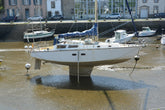As the winter season approaches, it's crucial to prepare your boat for the harsh weather conditions that lie ahead. Failing to properly winterize your vessel can lead to costly repairs and potentially irreversible damage. This comprehensive guide will walk you through the process of winterizing your boat, ensuring that it remains in pristine condition throughout the winter months.
Why is it important to winterize your boat?
Winterizing your boat is an essential step in preserving its longevity and preventing costly repairs. During the winter, freezing temperatures, moisture, and the potential for snow and ice buildup can wreak havoc on your vessel's systems and components. By taking the necessary precautions, you can protect your investment and ensure a smooth transition back to the water when the warmer weather returns.
The consequences of not winterizing your boat
Neglecting to winterize your boat can have severe consequences, including:
- Cracked engine block or manifold: Water left in the engine can freeze and expand, leading to costly engine damage.
- Burst water lines and tanks: Frozen water in the plumbing system can cause pipes and tanks to rupture.
- Mold and mildew growth: Moisture trapped in the boat's interior can lead to the development of mold and mildew, which can be difficult to remove and potentially harmful to your health.
- Battery drainage: Cold temperatures can drain your boat's battery, leaving you stranded when you attempt to start the engine in the spring.
- Gelcoat and upholstery damage: Exposure to the elements can cause fading, cracking, and deterioration of your boat's gelcoat and upholstery.
By investing the time and effort into properly winterizing your boat, you can avoid these costly and frustrating issues, ensuring a smooth and stress-free transition back to the water when the warmer weather returns.
Step-by-step guide to winterizing your boat
Follow this comprehensive step-by-step guide to ensure your boat is fully protected during the winter months:
Preparing the engine for winter
- Change the engine oil and filter: Fresh oil will help prevent the buildup of acids and contaminants during the winter months.
- Flush the engine cooling system: Use a non-toxic antifreeze solution specifically formulated for marine engines to prevent freezing and corrosion.
- Stabilize the fuel system: Add a fuel stabilizer to the gas tank and run the engine to distribute the treated fuel throughout the system. This will prevent fuel degradation and gum buildup.
- Fog the engine: Fogging the engine cylinders with a protective oil mist will help prevent corrosion and keep the internal components lubricated during storage.
Draining and flushing the water systems
- Drain the freshwater system: Locate the freshwater tank and drain it completely to prevent freezing and potential damage to the plumbing lines.
- Flush the raw water cooling system: Use a non-toxic antifreeze solution to flush the raw water cooling system, ensuring that all water is removed from the system.
- Drain the hot water heater: If your boat has a hot water heater, drain it completely to prevent the buildup of sediment and potential freezing damage.
Protecting the exterior of your boat
- Clean the hull and deck: Thoroughly clean the hull and deck to remove any dirt, salt, or debris that could cause staining or corrosion during the winter months.
- Apply a protective wax or sealant: A high-quality wax or sealant will help protect the gelcoat and prevent fading or oxidation.
- Cover the boat: Invest in a high-quality boat cover that will protect the exterior from the elements, including snow, ice, and UV rays.
Storing your boat during the winter months
- Choose a suitable storage location: Ideally, your boat should be stored in a dry, well-ventilated area, such as a heated indoor storage facility or a covered outdoor space.
- Properly support the boat: Use appropriate jack stands or boat stands to evenly distribute the weight and prevent stress on the hull.
- Protect the interior: Remove all loose items, open drawers and lockers, and place moisture-absorbing products inside the boat to prevent mold and mildew growth.
Common mistakes to avoid when winterizing your boat
- Neglecting to change the engine oil: Fresh oil is essential for protecting the engine during the winter months.
- Leaving water in the systems: Any remaining water can freeze and cause significant damage to plumbing lines, tanks, and the engine.
- Failing to stabilize the fuel system: Untreated fuel can degrade and lead to gum buildup, potentially causing engine issues in the spring.
- Improper storage: Storing your boat in an area prone to moisture, extreme temperatures, or potential damage from falling objects can lead to costly repairs.
Winterizing your boat checklist
To ensure you don't miss any crucial steps, follow this comprehensive winterizing checklist:
- Change the engine oil and filter
- Flush the engine cooling system with antifreeze
- Stabilize the fuel system
- Fog the engine cylinders
- Drain the freshwater system
- Flush the raw water cooling system with antifreeze
- Drain the hot water heater
- Clean the hull and deck
- Apply a protective wax or sealant
- Cover the boat
- Choose a suitable storage location
- Properly support the boat
- Protect the interior from moisture
Conclusion
Winterizing your boat is a crucial step in preserving its longevity and ensuring a smooth transition back to the water when the warmer weather returns. By following the step-by-step guide outlined in this article, you can protect your investment and avoid costly repairs. Remember, taking the time to properly winterize your boat now will save you both time and money in the long run.


![Veratron OL 43 Smart Marine Monitoring TFT Display [B00126101]](http://arcmarine.co/cdn/shop/files/111172XL_165x.jpg?v=1763678982)
![Veratron Suzuki VMH-35 PWM Display w/Sumitomo Connectors [B00204101]](http://arcmarine.co/cdn/shop/files/111170XL_165x.jpg?v=1763678982)



